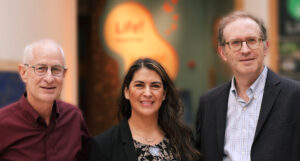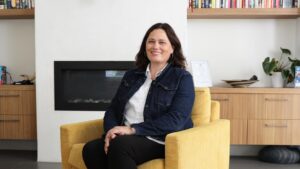
From Oct. 8-12, 2012, the USC Leonard Davis School of Gerontology welcomed delegates from The School of Applied Gerontology at the Windesheim University of Applied Sciences in Zwolle, the Netherlands.
For one week, Hugo van den Beld, M.A., professor Carolien Smits, PhD and Annelies Harps-Timmerman, MSc, RN met with the School’s faculty, staff and students; toured Southern California senior services and explored opportunities for collaboration between the institutions.
“We wanted to help advance the situation of older adults in both countries, to enhance the profile and visibility of the two schools and to create new opportunities for education, research and community projects,” said van den Beld, a USC Leonard Davis alum.
Smits, too, had a very personal connection with the School: founding USC Leonard Davis dean James Birren, widely acknowledged as the father of the field, had visited her grad school class 30 years ago in Nijmegen, The Netherlands.
“We had been told about his insights and the pioneering work of the Davis School, and his lecture impressed us a lot. What’s more, we were invited to join him for lunch. This was quite unexpected to us as modest students,” she said. “Jim Birren was sincerely interested in what students thought about gerontological matters. This taught me that no matter what age you are and how prestigious your work, you can always learn from and with students. I still try to practice this, thirty years onwards.”
Continuing this international collaboration was of utmost importance to the team, who faced challenges in their own country with many people unsure as to what gerontology even is.
“This was a fantastic opportunity for us to learn from a university where they have many years of experiences in the field we’re teaching,” Harps-Timmerman said. “Besides that, we were eager to explore options for Dutch students and lecturers to go abroad and learn from other cultures and countries. It’s a very powerful way to learn.”
As part of their visit, the trio also presented a special lecture, “Going Dutch: Aging in The Netherlands,” exploring innovations in senior housing, long term care and community services as well as holding a special workshop with members of the USC Leonard Davis School’s Fall Prevention Center of Excellence.
Building on the success of their visit, the team plans to expand their connection to the USC Leonard Davis School by looking into creating joint research and exchange programs and offering non-degree training opportunities.
“The response from our students and faculty to our Dutch visitors has been overwhelmingly positive, and we are excited to continue to explore the wonderful opportunities they have presented,” said Pinchas Cohen, MD, dean of the USC Leonard Davis School. “Gerontology is a truly global field of study and we are eager to promote the increased quality of life for older adults in every country.”
“Both of our Schools have a lot in common and this is a great beginning to a beautiful partnership,” van den Beld said. “We would like to thank everyone at the Davis School who has helped make this visit such a great one. We hope to see them again very soon, either in LA or in the Netherlands!”

 Eileen Crimmins, PhD, AARP Chair of the USC Leonard Davis School of Gerontology, capped off an impressive year with her election to the Institute of Medicine (IOM), one of the world’s most prestigious honors in the fields of health and medicine.
Eileen Crimmins, PhD, AARP Chair of the USC Leonard Davis School of Gerontology, capped off an impressive year with her election to the Institute of Medicine (IOM), one of the world’s most prestigious honors in the fields of health and medicine. After a long battle with Parkinson’s disease, USC Leonard Davis School of Gerontology professor emeritus David A. Peterson died on Thursday, October 4, 2012.
After a long battle with Parkinson’s disease, USC Leonard Davis School of Gerontology professor emeritus David A. Peterson died on Thursday, October 4, 2012. “United we stand, divided we fall” isn’t just a patriotic slogan – it’s also the rallying cry of Californians who joined forces with USC’s Fall Prevention Center of Excellence to celebrate the fifth annual Fall Prevention Awareness Week.
“United we stand, divided we fall” isn’t just a patriotic slogan – it’s also the rallying cry of Californians who joined forces with USC’s Fall Prevention Center of Excellence to celebrate the fifth annual Fall Prevention Awareness Week. Helping older adults has been USC Leonard Davis School of Gerontology graduate student Brenda M. Vázquez’s day job for almost a decade, but she prides herself on continuing to search for new avenues and opportunities to serve.
Helping older adults has been USC Leonard Davis School of Gerontology graduate student Brenda M. Vázquez’s day job for almost a decade, but she prides herself on continuing to search for new avenues and opportunities to serve.




